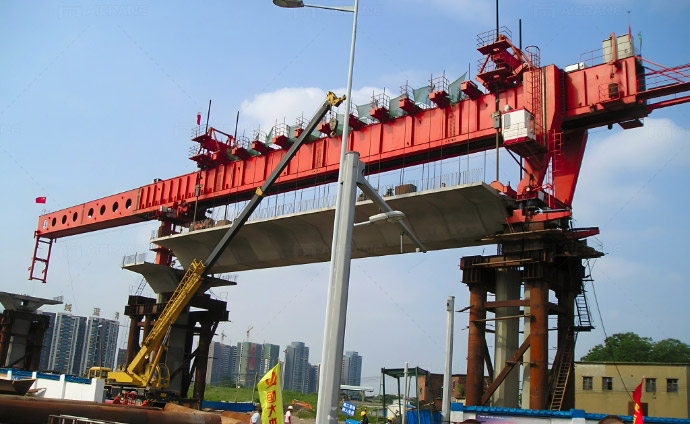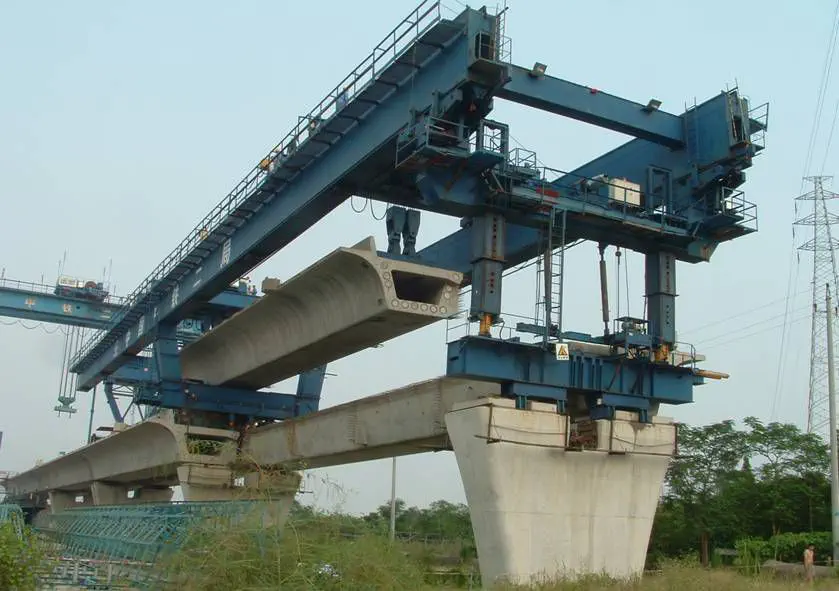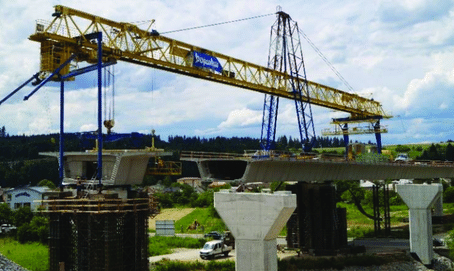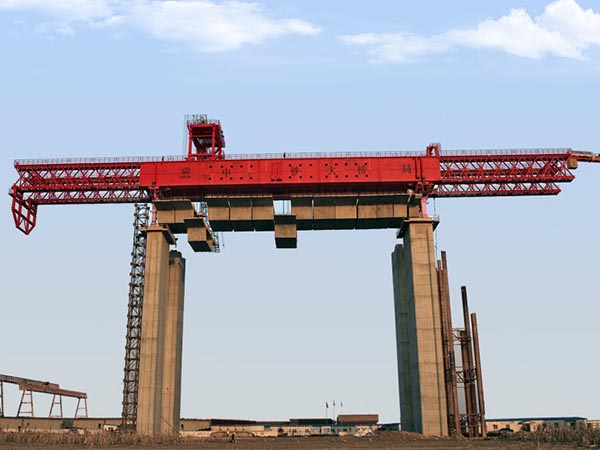A launching gantry is a specialised equipment used for erecting precast concrete segments in infrastructure projects. The launching gantry facilitates the span-by-span construction method, allowing for the continuous and efficient erection of segments. Its importance lies in its ability to significantly speed up the construction process, enhance safety by reducing the need for workers at great heights, provide precise control over segment positioning, and adapt to various bridge designs and challenging terrains, making it essential for constructing long-span bridges, elevated highways, and viaducts.
Where are launching gantries used?
- Bridges
- Elevated Highways
- Viaducts and Overpasses
- Rapid Transit Systems
- Railway Overbridges
- Marine Crossings
Components of launching gantry
- Main Girder: The primary horizontal beam that spans between piers or supports. It supports the weight of the precast segments and the gantry itself.
- Support Legs: Vertical structures that provide stability and support to the main girder. They can be fixed or adjustable to adapt to different pier heights.
- Trolleys/Carriages: Movable platforms on the main girder used to transport and position the precast segments. These are equipped with lifting mechanisms to hoist the segments into place.
- Winches and Hoists: Mechanical devices used to lift, lower, and accurately position the precast segments.
- Guiding Rails: Tracks along which the trolleys move, ensuring precise alignment and positioning of segments.
- Hydraulic Systems: These systems are used for lifting, aligning, and adjusting the position of the launching gantry and the segments it handles.
How does the launching gantry operate?
- Preparation: The launching gantry is assembled and positioned at the starting point of the bridge span, typically over the first set of piers.
- Segment Delivery: Precast segments are delivered to the site and loaded onto the trolleys or carriages of the gantry.
- Lifting and Positioning: The gantry lifts the segment into place, precisely aligns it with the previously erected segment, and temporarily secures it.
- Jointing: Segments are joined using post-tensioning or other fastening methods to ensure structural integrity.
- Advancement: Once a span is completed, the gantry moves forward to the next span, repeating the process.
Advantages of launching gantries
- Advantages of Using a Launching Gantry
- Quick and precise beam positioning.
- Ensures accurate alignment and placement.
- Reduces risks with a secure, elevated platform.
- Lowers labour cost and equipment expenses.
- Operates above existing infrastructure.
- Suitable for various bridge types and conditions.
- Speeds up the construction process.
- Less affected by weather conditions.
- Handles large and heavy bridge beams.
- Consistent beam placement and alignment.
- Integrates lifting, transporting, and placing.
- Effective for long spans and obstacles.
- Equipped with automated control systems.
Different types of launching gantries
Single-Girder Launching Gantry
The Single-Girder Launching Gantry is a basic yet effective form of equipment used in bridge construction. It consists of a single, horizontal girder supported by two vertical legs, forming a straightforward structure ideal for simpler bridge projects. This type of gantry is often employed for smaller spans and less complex bridge constructions due to its simplicity and cost-effectiveness. The single-girder design allows for easy assembly and disassembly, which can help reduce both construction time and expenses. It is particularly useful for projects with straightforward structural requirements where advanced features are not necessary, making it a popular choice for smaller, less demanding bridge constructions.

Double-Girder Launching Gantry
The Double-Girder Launching Gantry features two parallel horizontal girders supported by vertical legs, creating a more robust and stable structure compared to the single-girder version. This design is suitable for medium to large bridge spans and offers increased load-bearing capacity and stability. The dual-girder configuration is particularly advantageous for more complex bridge projects where heavier and larger beams need to be handled. Its enhanced structural support makes it a preferred option for a variety of bridge construction tasks, from moderately challenging projects to those requiring a more substantial and durable gantry system. This type of gantry provides the versatility needed for a wide range of bridge construction scenarios.

Cantilever Launching Gantry
The Cantilever Launching Gantry extends from a fixed support to place bridge beams, which is especially useful for cantilever bridge constructions. This design allows the gantry to work from a single point of support, enabling it to reach over existing infrastructure or obstacles. The cantilever mechanism is ideal for bridge projects where the construction must be performed over wide spans of existing structures. This type of gantry facilitates the creation of cantilever bridges by managing the complex requirements of spanning large distances or working around obstacles.

Overhead Launching Gantry
The Overhead Launching Gantry operates from an elevated position, which is particularly advantageous for bridge construction over existing infrastructure or restricted ground environments. By placing beams from above, this type of gantry minimizes ground-level disruption, making it suitable for urban areas or congested sites. The overhead design allows the gantry to work efficiently in environments where ground-level space is limited or where it is important to avoid disturbing existing infrastructure. This approach is ideal for projects that need to manage space constraints and minimize ground disturbance.

Specialized Types of Launching Gantry
Self-Erecting Launching Gantry
The Self-Erecting Launching Gantry incorporates mechanisms that allow it to adjust its height as needed during the construction process. This adaptability is particularly valuable in projects where varying bridge heights or challenging terrains are encountered. The self-erecting capability enables the gantry to manage different construction stages and terrain conditions without the need for extensive reconfiguration. This type of gantry is suited for complex bridge projects that involve changing elevations or difficult ground conditions, providing the flexibility required to handle diverse and dynamic construction environments.
Track-Mounted Launching Gantry
The Track-Mounted Launching Gantry operates along tracks that are laid along the bridge’s alignment, providing a stable and controlled environment for beam placement. This type of gantry is particularly useful for ensuring precise alignment during the bridge construction process. The tracks offer a reliable and stable platform for the gantry to move along, which is essential for accurate beam placement over long distances. Track-mounted gantries are employed in projects that require meticulous alignment and stability, making them suitable for large spans and complex bridge designs where precision is a key requirement.
Hydraulic Launching Gantry
The Hydraulic Launching Gantry utilizes hydraulic systems to manage the lifting and positioning of bridge beams, offering a high level of control and smooth operation. This advanced gantry type employs hydraulic mechanisms to achieve fine adjustments during beam placement, which is crucial for maintaining accuracy in complex bridge constructions. The hydraulic system allows for precise and stable beam placement, making it an excellent choice for projects that require detailed control and efficient operation. The hydraulic launching gantry is particularly beneficial for bridge constructions where precise movements and adjustments are essential for successful project execution.
Modular Launching Gantry
The Modular Launching Gantry is composed of interchangeable components that can be assembled and customized based on the specific requirements of the bridge construction project. This type of gantry offers significant flexibility and adaptability, making it suitable for various bridge designs and construction challenges. The modular nature allows for modifications and adjustments to meet different project needs, providing a versatile solution for diverse bridge construction tasks. Its ability to be reconfigured for different projects makes it a valuable tool for achieving tailored solutions in bridge engineering.
Conclusion
Launching gantries are essential for efficient and safe bridge construction, offering a variety of solutions to meet diverse project needs. As technology advances, launching gantries continue to evolve, expanding their capabilities and applications in the bridge construction industry, thus playing a crucial role in meeting the demands of modern infrastructure development.

